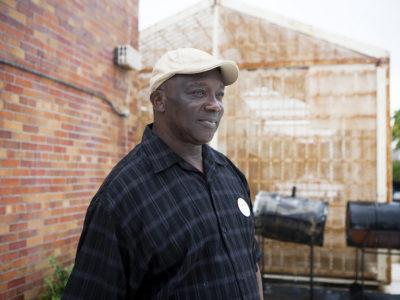This blog was first published by International City/County Management Association (ICMA) on August 1, 2021.
Built for Zero is a global movement of communities working to measurably reduce and end homelessness. Community Solutions, the nonprofit that leads Built for Zero, was recently awarded the MacArthur Foundation’s 100&Change grant for $100 million, which will be used to help accelerate an end to homelessness in the United States through Built for Zero.
This article describes the origins of the movement, the four common characteristics of any community that is designed to end homelessness, and lessons from cities across the globe implementing this methodology.
When we share our commitment to ending homelessness, we are accustomed to the inevitable follow-up. There is rarely disagreement on the need. The question is whether getting to zero homelessness—and sustaining that end—is really possible.
Since 2015, we have worked with communities to answer that question. Even some of the most committed local leaders battled with their own skepticism. “No one thought it was attainable at the beginning,” said Heather Kimmel. “It wasn’t something we thought we’d ever actually be able to do.”
Kimmel is the assistant executive director at the Housing Authority of the County of Kern, a county of just under a million people about two hours from Los Angeles. In January 2021, the community reached a milestone known as functional zero for chronic homelessness, meaning fewer than three people remained in the entire county with serious health conditions and long-term histories of homelessness. Chronic homelessness accounts for the vast majority of spending on homelessness in most communities, and is widely considered the most difficult part of the problem to solve.
Kern County’s achievement was groundbreaking—the first community in California to reach this milestone. But the county is not alone in making progress. It’s part of an initiative known as Built for Zero, which includes more than 80 U.S. communities working to measurably and equitably end homelessness. This diverse network includes six of the 20 largest cities in the country and a mix of suburban, urban, and rural contexts. To date, 14 participating communities have functionally ended veteran or chronic homelessness, and 46 have driven reductions in the number of people experiencing homelessness.
In places like Canada, Denmark, Australia, and the United Kingdom, a network of partners is adapting the Built for Zero methodology and integrating it with key, locally sourced innovations to establish community systems designed to continuously reduce and end homelessness. Collectively, we are working toward a new reality where homelessness is rare and brief when it happens.
There are many, well-known technical interventions that communities must apply to end homelessness for individuals — the increasingly accepted Housing First approach, for example. But these individual-level interventions do not, by themselves, end homelessness at the community level. For that, communities need to reorganize the way local actors work together and engage in collective problem solving. Four defining features have emerged in communities that have successfully reduced or ended homelessness:
- An integrated, community-wide team.
- Shared accountability for a community-wide aim.
- Real-time, by-name data on homelessness.
- The use of real-time data to target key resources and interventions flexibly.
An Integrated, Community-Wide Team
In most communities around the world, a vast collection of organizations and agencies touch homelessness in some way, but no one is fully accountable for reducing and ending it. Communities adopting the Built for Zero methodology create a shared structure for collective action so that local players can transcend the demands of individual programmatic work and collaborate effectively as one team.
Kern County exemplifies the point. It faced all the challenges of a typical fragmented housing ecosystem, where each program had its own funders, compliance requirements, and siloed outcomes frameworks. After committing to reach zero together, local players worked to integrate their efforts and deputized the local housing authority to keep them organized. Agencies began sending their frontline staff to joint meetings, where they would discuss clients common to multiple programs and the next steps required to move them into housing.
A level up, decision-makers at each agency began meeting to identify gaps and bottlenecks in the community’s broader housing system. They organized a monthly ideas meeting where people proposed new ideas to test together, wrote predictions, and evaluated results. This created space for agencies to come together and think about population-level outcomes, rather than confining themselves to program updates or administrative discussions. The participants soon developed a shared mantra: “Not my clients, but our clients.”

“Not my clients, but our clients.”
Creating Accountability Through a Shared Aim
Building an integrated team like Kern County also allowed each local actor to commit to a shared, community-wide aim. Instead of program outcomes like, “house 50 people,” imagine system-wide outcomes like, “achieve zero street sleeping across an entire community.”
The Danish municipality of Hjørring was facing a problem of rising numbers in its shelters, especially among young people ages 18 to 30. In collaboration with the private consultancy, Trancit, Hjørring leaders secured funding from the National Board of Health and Welfare to deploy key components of the Built for Zero methodology locally.
Participants chose to align their efforts around a shared aim: reduce youth homelessness, including youth in severe risk of experiencing homelessness, by 80 percent in 2.5 years, based on an estimate of what 100 percent would look like. This shared aim created a shared lens through which to filter every decision, and it allowed for rapid adoption of other key components of the methodology: the creation of a real-time list of all young people experiencing homelessness, for example, and a universal screening and eligibility protocol for connecting young people with housing and social support.
In just one year, the team in Hjørring successfully reduced that number by 82.5 percent, based on the aim estimate. They also identified 860 percent more young people experiencing homelessness than national figures suggested.
Equipping Communities with Quality, Real-Time, By-Name Data
You can’t solve a problem you can’t see, but most communities are working with stale, poor quality data on homelessness. In the United States, Canada, and Australia, for example, communities are required to assess the scale of homelessness just once every one to two years, and on just a single night. By contrast, homelessness itself is incredibly personal and dynamic—new people enter and exit nightly, and each person has different needs.
Communities that adopt the Built for Zero methodology commit to meeting a series of data quality standards in order to monitor homelessness comprehensively and by name on at least a monthly basis. The result is a clear line of sight into broader system dynamics like inflow, outflow, and process bottlenecks.
In Adelaide, Australia, the Adelaide Zero Project team began with a real-time, by-name list of rough sleepers, who are those sleeping outside. By tracking anyone with a history of rough sleeping over the last year, the team was able to capture the full universe of rough sleepers, even those who might currently be in shelter, segment out the most frequent and longest-term rough sleepers in the city, and prioritize them for permanent housing. This data proved especially critical during the early days of the COVID-19 pandemic, when the team had to prioritize limited permanent housing resources for those quarantining in hotels and motels.
This level of data quality is possible in much larger cities, as well. Toronto, Canada, is working to achieve quality data by the end of the year and opted to begin by developing real-time data on people using its homeless shelter system—a smart way to get started with a manageable piece of the problem. Using Built for Zero data quality standards adapted by the Canadian Alliance to End Homelessness, they created a set of live dashboards that aggregate data on everyone who accesses a shelter, respite, hotel/motel program, or warming center on a rolling three-month basis. The Toronto Alliance to End Homelessness, the Toronto Indigenous Community Advisory Board, the City of Toronto Shelter Support and Housing Administration, and many community-based shelter and support organizations worked together to ensure this data was reliable, comprehensive, and could be updated across the entire city in real time.
Today, all partners can easily track the inflow and outflow of people in the shelter system each month. Over time, this provides a much better understanding of both the scale of homelessness in Toronto, and more importantly, the near-term impact of funding and policy decisions, including what’s working and what needs revisiting.
Enabling Communities to Target Resources for Reductions
The city of Detroit had the quality data to know every military veteran experiencing homelessness by name and in real time. It had a strong coordinated team that included exceptional leadership from the local Veterans Affairs Medical Center. Together, the community was working to steadily drive reductions in veteran homelessness toward its shared aim of reaching functional zero.
But despite the community’s continued reductions efforts, the number of veterans experiencing homelessness consistently stalled around 250 in 2018. The local team began to explore what was contributing to this phenomenon and found that 250 was the number of beds available through the Grant and Per Diem program, which offers service-intensive transitional housing programs for veterans on a per diem basis and creates an unintended incentive to keep beds full rather than moving people through quickly.
Local leaders worked to strategize how they could change the system from within to ensure veterans could access GPD without remaining there longer than necessary on their journey to permanent housing. The team began to focus on offering veterans initial options that would facilitate a faster route to permanent housing, which included vouchers provided through the Department of Veterans Affairs (VA) that could be used for permanent supportive housing or connecting them with other shelter options. The community also harnessed local philanthropic dollars from Rocket Mortgage to help providers of the transitional housing convert their properties to permanent housing, which would help them collectively rightsize the number of grant and per diem beds to match the scale of need. As a result, Detroit has now driven nearly a 40 percent reduction in veteran homelessness in just two years and continues to move toward zero.
Homelessness Is Solvable
Homelessness is widely understood as an urgent tragedy of public health, equity, and justice requiring attention. Unfortunately, for too long, it has also been misunderstood as a problem that is intractable.
But these communities across the globe are proving otherwise. Communities are driving reductions in homelessness so that it continuously remains rare across a population. Individuals experiencing homelessness in these communities are known by name and quickly connected to a system that can provide the support they need to exit homelessness.
Local leaders have proven they have a key role in delivering and sustaining these results. They are using their influence to convene community-wide teams; create accountability for a shared aim; establish quality, real-time data that can catalyze progress; and target resources for reductions in homelessness.
All communities have the power to help make this reality a norm, rather than the exception. Together we must not only assert that homelessness is solvable, but be a part of a collective movement creating proof of it every day.
The authors thank Candace Morgan, David Pearson, K.O. Campbell, Louise Marie Pedersen, Marie Morrison, Heather Kimmel, and Tim Richter for their contributions.




